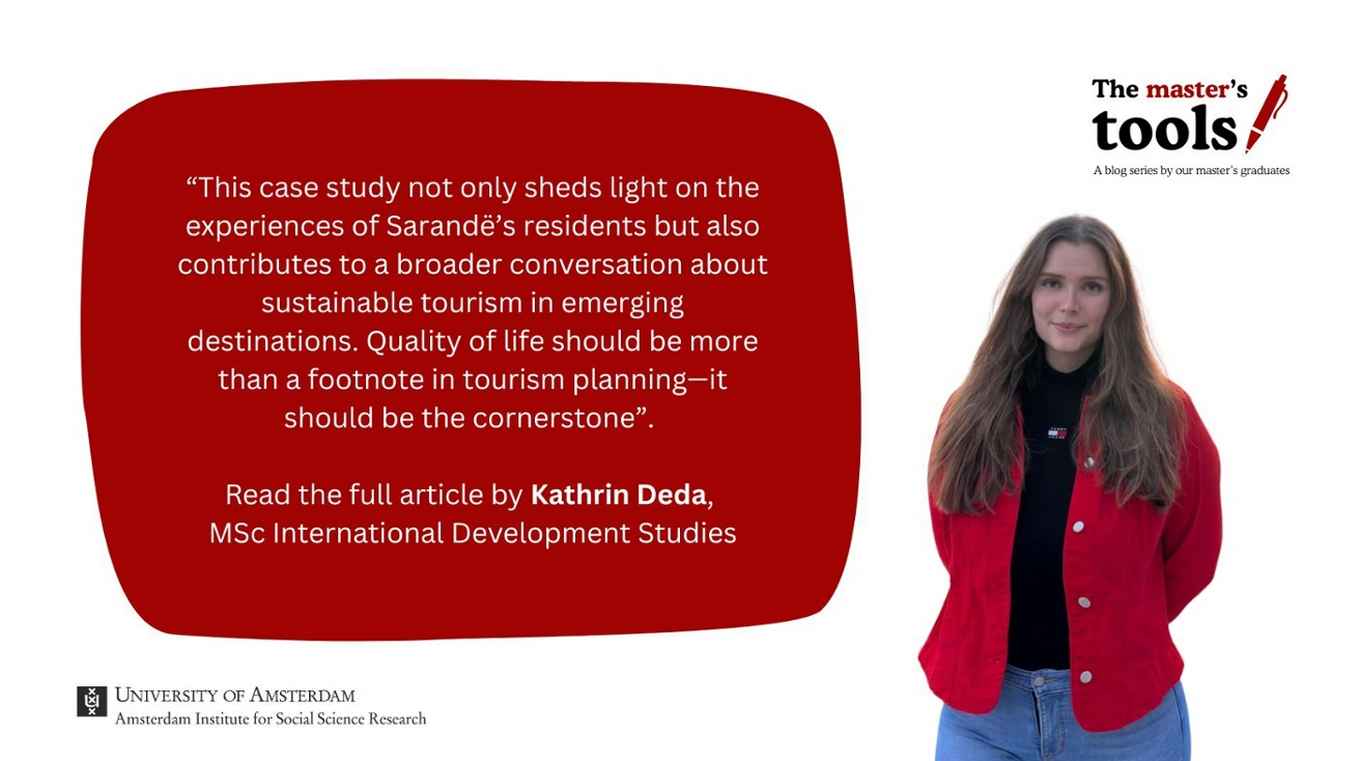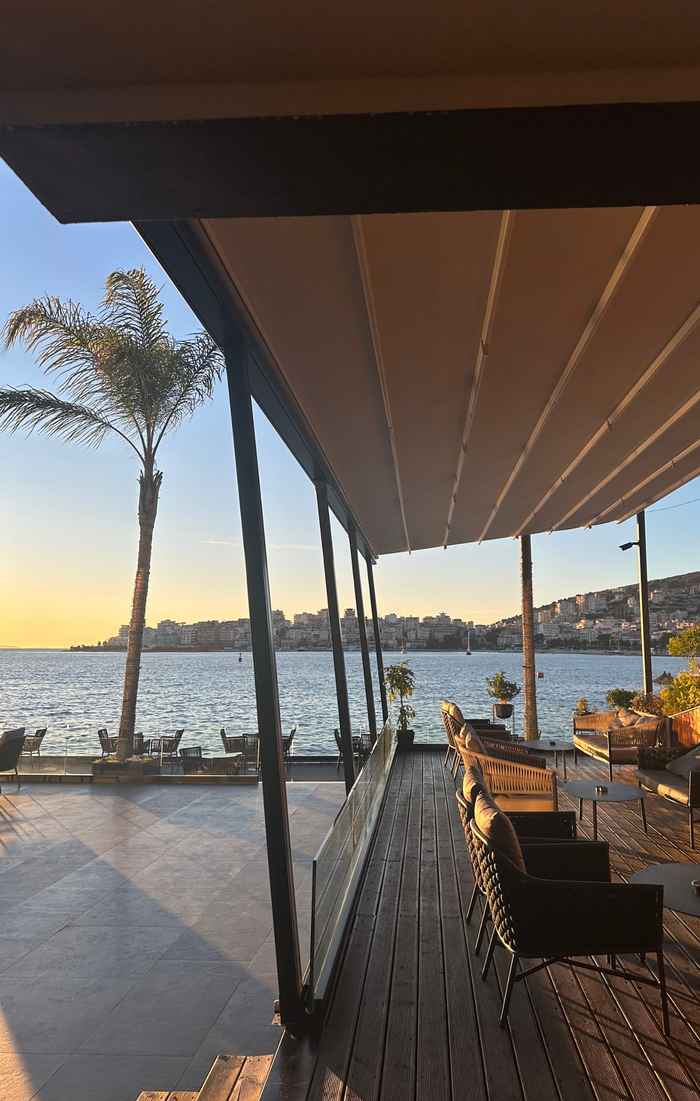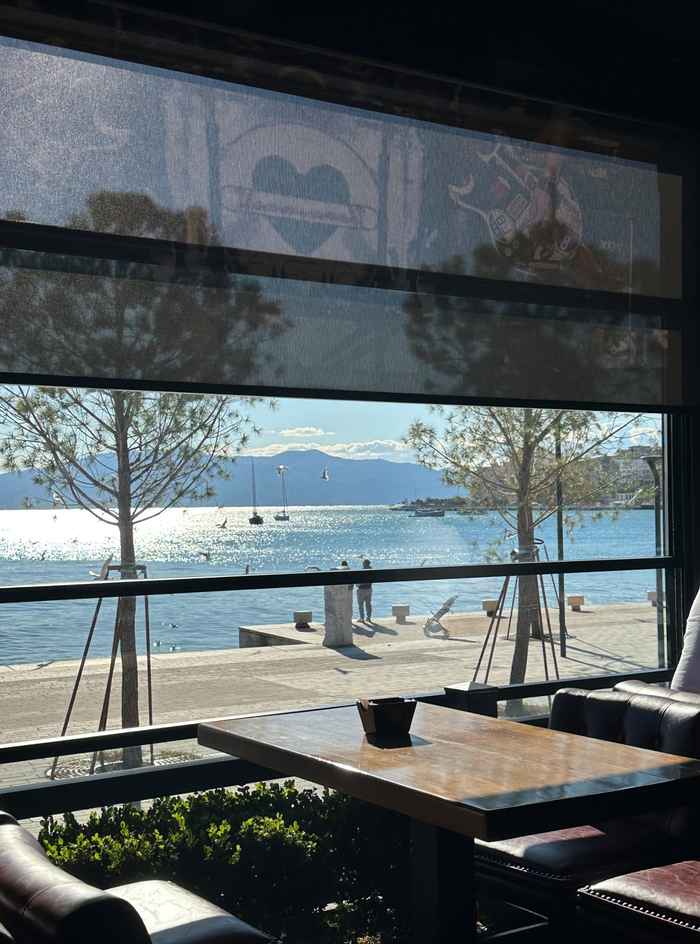Finding the Balance: Tourism and Quality of Life in Sarandë, Albania
By Kathrin Deda, Alumni of the Master of International Development Studies Program
1 September 2025

Growing up Albanian in the diaspora, I first came to know Albania through memories, photographs, and family stories—an introduction that only heightened my curiosity about the country itself: its history, culture, and the transformations it has experienced in recent decades. Over time, this enduring connection became more than a personal anchor; it grew into the driving force behind my academic journey and ultimately shaped the focus of my master’s research.
My master’s thesis, completed as part of the MSc in International Development Studies at the University of Amsterdam, explores this dynamic by asking: How do residents of Sarandë perceive tourism’s impact on their Quality of Life (QOL)? Sarandë, a coastal city in southern Albania, has experienced a dramatic tourism boom in recent years, becoming a focal point for discussions around economic opportunity, cultural preservation, and sustainable development.
I chose this topic because tourism is often portrayed as an unquestionable force for economic growth, yet its real impact on communities is far more complex. Albania—and Sarandë in particular—offers a unique lens for exploring these complexities, as the country navigates rapid change after decades of isolation. Drawing on a mixed-methods approach and surveying 141 residents, my research uncovers how tourism affects economic conditions, social life, and the environment, shaping the way locals experience development in their daily lives.
These findings are not just relevant for Albania—they resonate with many destinations around the world where communities are grappling with the balance between welcoming visitors and preserving quality of life.
Moving beyond the tourist gaze
While most tourism research tends to focus on travelers—their satisfaction, spending patterns, and impact on local economies—sustainable tourism also depends on the support, well-being, and experiences of residents. For this reason, my study aimed to shift the focus back to the residents living in Sarandë. By centering their voices, my research seeks to illuminate how tourism shapes not only the economy but the social fabric and quality of life of those who experience it firsthand.

Quality of Life
I used four key domains to measure Quality of Life (QOL):
- Material well-being (e.g., income, job opportunities)
- Health and safety (e.g., pollution, crime rates)
- Community well-being (e.g., infrastructure, services)
- Emotional well-being (e.g., social connection, cultural pride)
These domains capture both the tangible and intangible aspects of daily life—ranging from income and safety to social connections and pride in one’s community. Using Likert-scale surveys distributed in Albanian, I measured residents' perceptions in each area, and I complemented this with an analysis of relevant tourism policies at both national and municipal levels to contextualize the findings.
What the data reveals
The results revealed a mostly positive perception of tourism among Sarandë’s residents. Respondents particularly appreciated improvements in public spaces and the increased visibility of local culture. Emotional and community well-being were rated highest, indicating that tourism is seen as enhancing local pride and fostering social interaction. However, material well-being scored the lowest. While tourism creates jobs, many of these are seasonal or insecure, and rising living costs threaten to outpace the benefits for some residents. Concerns about environmental pollution and infrastructure strain were also noted, especially during peak tourist season. Age and employment status emerged as key variables in shaping perception. Younger residents and those employed in the tourism sector tended to express more positive views. This finding, in fact, underscores how experiences of tourism are unevenly distributed and often tied to socioeconomic position.
A policy disconnect
From analyzing Albania’s National Strategy for Sustainable Tourism Development (2019–2023) alongside Sarandë’s local planning documents, these policies rightly focus on economic growth and infrastructure expansion. However, they pay less attention to residents' well-being and environmental concerns. Community participation is often missing from planning processes, leaving locals feeling excluded from decisions that directly affect their lives. This gap suggests a need to reframe tourism planning—not just as a tool for economic development, but as a holistic strategy that balances economic, social, and environmental sustainability.

Why quality of life matters
The success of any tourist destination relies not just on visitor numbers, but on the quality of life of the people who already live there. If residents feel overwhelmed, displaced, or excluded, they are less likely to support tourism in the long run. Research shows that destinations with high resident satisfaction also tend to offer better experiences to tourists. By measuring the quality of life of residents of touristic areas we gain a deeper understanding of how development feels on the ground. It allows us to assess not just whether tourism “works,” but “for whom” and “at what cost”.
Looking ahead
Tourism in Sarandë has brought clear benefits—but not without trade-offs. Understanding the multifaceted ways tourism shapes quality of life is essential for developing policies that benefit both visitors and residents. As Albania continues to grow as a tourism destination, striking a balance between development and community well-being will be vital. This case study not only sheds light on the experiences of Sarandë’s residents but also contributes to a broader conversation about sustainable tourism in emerging destinations. Quality of life should be more than a footnote in tourism planning—it should be the cornerstone.
As Albania continues to develop its tourism sector, prioritizing local quality of life will be essential to ensuring sustainable and inclusive development. Tourism is not inherently good or bad—it depends on how it is managed. By centering the experiences of those who live in tourist destinations, we can chart a course that truly benefits all stakeholders.